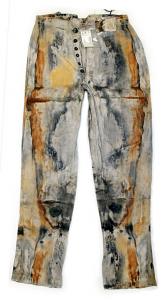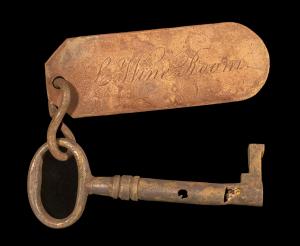California Gold Rush sunken treasure from legendary 'Ship of Gold' that sank in 1857 to be displayed in Reno, July 28-31

19th-century daguerreotype photograph of an unidentified young woman that the scientific mission recovery team nicknamed, “Mona Lisa of the Deep” because of the exceptional depth of field, contrast, and focus. (Photo credit: Holabird Western Americana Col

This pair of canvas jeans with a button fly, recovered from the 1857 sinking of the S.S. Central America, is the oldest known Gold Rush-era jeans of their kind and may have been made by Levi Strauss in his early years in business. (Photo credit: Holabird

This important green bottle recovered from the S.S. Central America is a rare surviving example of a Gold Rush-era wide-mouth glass tool used in obtaining samples from a wine barrel. (Photo credit: Holabird Western Americana Collections.)
Items will include gold jewelry, jeans that may have been made by Levi Strauss, vintage ornate bottles, and a mysterious “Mona Lisa of the Deep” photograph.
“Among the notable, recovered items are the lid to the oldest known Wells Fargo treasure shipment box; 1857 clothing including a pair of the earliest known Gold Rush-era canvas work pants jeans with a button fly that may have been made by Levi Strauss in his early years in business; photographs; jewelry made from California Gold Rush ‘mother lode’ native gold in quartz as gemstones; and, of course, bottles,” said Fred Holabird, president Holabird Western Americana Collections, LLC (www.HolabirdAmericana.com) of Reno, Nevada.
“There is even a key to the ship’s wine storage room and an S.S. Central America brass name tag attached to a set of keys that belonged to the ship’s purser. We believe these were for the locked room where the gold treasure cargo was kept,” he explained.
One of the important, recovered jewelry items is a large 18-karat gold quartz engraved brooch that prominent San Francisco businessman Samuel Brannan was sending to his son in Geneva, Switzerland, as a gift to the son's teacher.
“These historic items are a time capsule from the California Gold Rush,” Holabird stated.
The recovered artifacts will be offered in public auctions in October and November by Holabird Western Americana Collections.
“These incredible artifacts that were in secure storage in three different states are now giving us a glimpse of Gold Rush-era daily life for passengers and crew in the 1850’s,” said Dwight Manley, Managing Partner of the California Gold Marketing Group of Brea, California, which owns the recovered items.
The jeans were discovered in a trunk belonging to passenger John Dement who survived the sinking. They are now insured for $1 million, according to Manley.
Some 19th-century photographs were also recovered. One daguerreotype metal plate photograph of an unidentified young woman was nicknamed, “Mona Lisa of the Deep,” by the scientific mission recovery team that retrieved the mysterious photo from the seabed where it was discovered in a scattered pile of the ship’s coal.
“Other items recovered include pistols; brass luggage tags; passengers’ ticket receipts; galley utensils and dishes; ornate, flint glass wine and spirits decanters that appear to have been a standard amenity in the first-class staterooms; eyeglasses in solid gold frames; and even chewing tobacco in a pouch apparently from the 1851 London World’s Fair,” Holabird revealed.
The S.S. Central America sank 7,200 feet deep in the Atlantic Ocean off the North Carolina coast during a hurricane on September 12, 1857. She was on a voyage from Panama to New York carrying tons of California Gold Rush coins, ingots, and gold dust from the San Francisco and Northern California area. The tragedy took the lives of 425 of the ship’s 578 passengers and crewmembers, and the loss of the gold cargo was a major factor in the economically devastating financial Panic of 1857 in the United States.
Recovery from the shipwreck site of what has been described as “America’s greatest treasure” occurred in several stages between 1988-1991 and again in 2014. Thousands of retrieved gold coins and hundreds of gold bars have been sold since 2000; however, these latest items were kept in storage in three different states, Maryland, Massachusetts, and Ohio, until a court-approved settlement was reached ending a decades-long ownership dispute.
“Seemingly ordinary items from the passengers and crew today give us extraordinary insight into the everyday lives of the people who traveled on the steamship,” said scientist Bob Evans who was on each of the recovery missions and will be at the exhibit in Reno to talk to visitors about the “Ship of Gold” and the recovered Gold Rush artifacts.
For additional information about the recovered artifacts and auctions planned for October and November, visit Holabird Western Americana Collections of Reno, Nevada at www.HolabirdAmericana.com, call 775-851-1859, or email info@holabirdamericana.com.
# # # #
Fred Holabird
Holabird Western Americana Collections
+1 775-851-1859
email us here
Legal Disclaimer:
EIN Presswire provides this news content "as is" without warranty of any kind. We do not accept any responsibility or liability for the accuracy, content, images, videos, licenses, completeness, legality, or reliability of the information contained in this article. If you have any complaints or copyright issues related to this article, kindly contact the author above.


